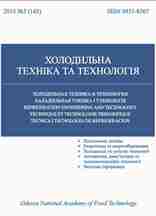МОДЕЛЮВАННЯ ТЕЧІЙ В ВАКУУМНИХ СИСТЕМАХ
DOI:
https://doi.org/10.15673/0453-8307.4/2013.57333Ключові слова:
Мікротріщини, Вакуумні системи, Фрактальні моделі, Витік газів, Деревовидні мікроканалиАнотація
Розглянуто фрактальну модель мікротріщин в матеріалі стінок охолоджуваних вакуумних посудин для експериментального зразку термоядерного реактора. Наведено оцінку втрати тиску при течії рідини через мережу мікроканалах. Фізичний механізм проникнення потоку охолоджуючої рідини через гіпоте-тичні щілини і тріщини, що утворюють деревоподібну структуру мікроканалів, описується лінійними співвідношеннями термодинаміки для заданого перепаду тисків на стінках посудини. На основі методів комп'ютерної флюідної динаміки в рамках однорідної моделі суцільного середовища розраховано витра-ти рідини для ізотермічного потоку.Посилання
http://en.wikipedia.org/wiki/ITER 2. Liu, B., Shi, C., Gu, F., and Bhandari, S., Leak Rate Evaluation for Through-Wall Cracks, Transactions SMiRT 16, Washington DC, 2001. 3. Sharipov F., ‘Non-isothermal gas flow through rectangular microchannel’, J. Micromech. Microeng. 9 (1999), рр. 394-401. 4. Pantazis, S. Varoutis, S. Hauer, V. Day C., Valougeorgis D. Gas-surface scattering effect on vacuum gas flows through rectangular channels. Vacuum, 85 (12, SI) 2011, pp. 1161–1164. 5. S. Varoutis,V. Hauer, C. Day, S. Pantazis, D. Valougeorgis Experimental and numerical investiga-tion in flow configurations related to the vacuum sys-tems of fusion reactors. Volume 85, Issues 10–12, December 2010, Pages 1798–1802. Proceedings of the Ninth International Symposium on Fusion Nuclear Technology. 6. Sharipov F. Numerical simulation of rarefied gas flow through a thin orifice. J Fluid Mech 2004; 518: рр. 35-60. 7. Varoutis S, Valougeorgis D, Sazhin O, Sharipov F. Rarefied gas qf low through short tubes into vacu-um. J Vac Sci Technol A 2008; 26(2): рр. 228-238. 8. Sharipov F, Kozak D. Rarefied gas flow through a thin slit into vacuum simulated by the Monte Carlo method over the whole range of the Knudsen number. J Vac Sci Technol A 2009; 27(3): рр. 479-484. 9. Cherepanov, G., Balankin ,A., Ivanova V. Frac-tal Fracture Mechanics--a Review .Engineering Frac-ture Mechanics Vol. 51, No. 6, pp. 997-1033, 1995 10. Erdem, S., Blankson M. Fractal–fracture analysis and characterization of impact-fractured surfaces in different types of concrete using digital image analysis and 3D nanomap laser profilometery. Construction and Building Materials. Volume 40, March 2013, рр. 70-76 11. Travis J. R, Spore J. W. Royl P., Lam K. L., Wilson T. L., Müller C. Necker G. A. Nichols B. D., Redlinger R., (GASFLOW: A Three-Dimesional Finite-Volume Fluid-Dynamics Code for calculating the Transport, Mixing and Combustion of Flammable Gases and Aerosols in Geometrically Complex Do-mains, Volume 1, Theory and Computational Model. 12. Wagner, W. and Pruss, A., 2002, The IAPWS formulation 1995 for the thermodynamic properties of ordinary water substance for general and scientific use, Journal of Physical and Chemical Reference Data, 31, рр. 387-535. 13. COMSOL: http://www.comsol.com. 14. ITER Documentation Series,. Blanket, Shield Design and Material Data, Base No 29, IAEA, Vienna 1991. 15. B.B. Mandelbrot, The Fractal Geometry of Na-ture// Freeman, New York, 1982. 16. A. E. Velasco, S. G. Friedman, M. Pevarnik, Z. S. Siwy, and P. Taborek. Pressure-driven flow through a single nanopore Physical Review E86, 025302(R), 2012.


